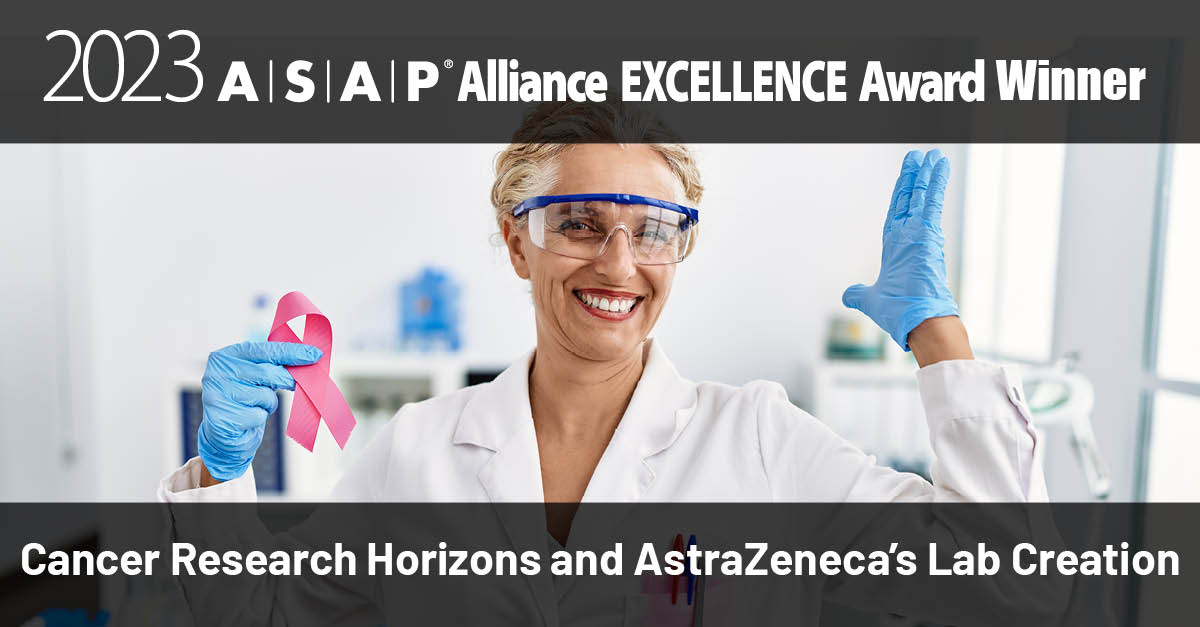Cancer Research Horizons and AstraZeneca’s Lab Creation: An Alliance Excellence Award Winner
Toward the middle of the last decade, Cancer Research UK’s Therapeutic Discovery Lab had proven itself capable of developing small molecules into clinical-trial candidates, but had limited experience with developing antibody therapeutics in-house.
In 2014, the world's leading independent charity dedicated to cancer research turned to AstraZeneca to establish the Antibody Alliance Laboratory (AAL), in which more than a dozen employees from the nonprofit team and two AstraZeneca secondees work side-by-side developing antibody targets. The partnership made sense on paper. Cancer Research UK brought an international network of academic scientists with ambitious projects, while AstraZeneca had the technological know-how and material resources to fuel them.
Fast forward to 2022. The Cancer Research UK Therapeutic Discovery Lab is now part of Cancer Research Horizons, the innovation engine for Cancer Research UK. The AAL and its academic partners have actively pursued 16 major antibody projects within its portfolio, one-quarter of which now have intellectual property associated with them. One of these candidates, Arginase-II, which has potential for cancer and noncancer indications, has generated two publications while it awaits patent approval. Another, ZFTA-RELA, is a diagnostic antibody that may help predict whether patients with ependymomas, a rare childhood brain cancer with poor survival outcomes, will respond to intensive radiotherapy or not.
The progress achieved by the AAL, and the unique nature of this industry-charity relationship, netted the partners a 2023 ASAP Alliance Excellence Award for Individual Alliance Excellence in the Longstanding subcategory.
Bottoms-Up: The Glass—and the Pipeline—Are More Than Half-Full with Diverse Projects
You could make the argument that the uniqueness of colocating principal scientists in a permanent laboratory work arrangement was enough for these organizations to earn the honor. Maria Groves, PhD, lab head of the antibody alliance laboratory at AstraZeneca, and Ewan Hughes McInnes, strategic alliance manager at Cancer Research Horizons, went into detail about the advantages the AAL provided during the annual ASAP Alliance Excellence Award ceremony last month.
“Management and governance of the lab is completely integrated between the two organizations, and the daily face-to-face interactions have allowed for a positive bottom-up collaborative culture to develop within the alliance,” said Groves.
But the novel alliance practices didn’t end with the lab itself. The two organizations took a different tack in expanding its pipeline of targets. Instead of establishing a rigid picture of the ideal cancer target (i.e., limiting efforts to one or a small set of diseases), the scientists running the AAL are free to pursue just about any oncology-related initiative built on promising science.
“We are disease- and mechanism-agnostic and are proud to have a diverse range of projects in the portfolio,” said Hughes McInnes.
The alliance managers are tasked with finding third parties and establishing contracts that lead to fruitful new relationships. One such collaboration, with the Karolinska Institute in Sweden, has morphed into its own separate alliance with Cancer Research Horizons.
Assessing Science—and the Alliance—by Committee
Every good alliance is underpinned by strong executive sponsorship and governance. The AstraZeneca–Cancer Research Horizons relationship put a slight twist on the usual biopharma structure. Its Joint Steering Committee (JSC) meets only twice a year rather than the typical quarterly gathering to settle disputes and make key strategic decisions. Every month or month and a half or so, the Joint Management Committee (JMC) convenes to assess KPIs around the current science in play and reallocate resources accordingly. The alliance also has a Target Steering Committee (TSC) that reviews academic proposals regularly throughout the year.
Like any nearly decade-old alliance, the collaboration sees turnover every now and then, and the alliance managers are diligent about updating the charter so that new members can be properly onboarded.
“Our current governance structure promotes new initiatives and scrutinizes high-level scientific work plans,” said Hughes McInnes. “It is an effective vehicle for engaging and leveraging internal expertise across our organizations.”
There are currently eight projects in various stages of development at the AAL, while several other candidates are being evaluated at any given time.
The collaboration, like the therapies it is beginning to develop, remains on target.

